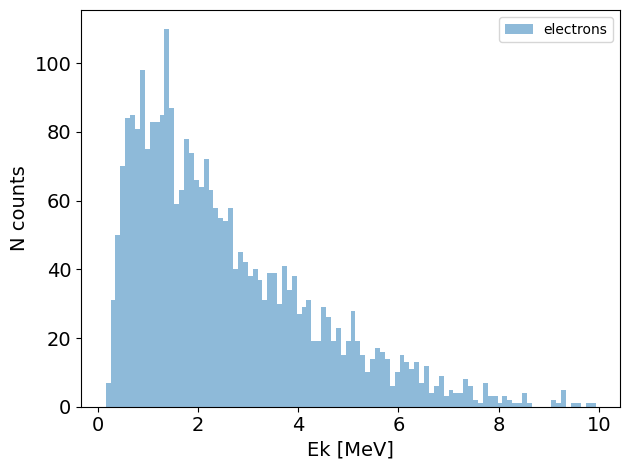Writing a new data exporter
Writing a new DataExporter is very similar process to writing a new DataLoader. As an example: lets say that I want to export some topas to the same format used in the data import example:
x (mm) y (mm) z (mm) px (MeV/c) py (MeV/c) pz (MeV/c) E (MeV)
Note that these units already match those in the unit set of
mm_MeV
To do this, we would create a data exporter as follows:
[1]:
from pathlib import Path
import sys
sys.path.append('../')
from ParticlePhaseSpace.DataExporters import _DataExportersBase
from ParticlePhaseSpace import DataLoaders
from ParticlePhaseSpace._ParticlePhaseSpace import PhaseSpace
import numpy as np
import ParticlePhaseSpace.__particle_config__ as particle_cfg
from ParticlePhaseSpace import ParticlePhaseSpaceUnits
class NewDataExporter(_DataExportersBase):
def _define_required_columns(self):
pass
def _export_data(self):
pass
def _set_expected_units(self):
pass
Our job is to fill in these blank methods.
in
_define_required_columnsyou must list all the columns required for your data export. These column names must match the allowed columns from the phase space specification.in
set_expected_unitsyou should list the units your exporter is expecting. If the units in the data it receives are different, it will attempt to convert the data to the correct units._export_datais where the data export will actually happen.
The filled in data exporter for the case in hand looks like this:
[2]:
class NewDataExporter(_DataExportersBase):
def _define_required_columns(self):
self._required_columns = ['x', 'y', 'z', 'px', 'py', 'pz', 'Ek']
def _set_expected_units(self):
self._expected_units = ParticlePhaseSpaceUnits()('mm_MeV')
def _export_data(self):
if not Path(self._output_name).suffix == '.dat':
_output_name = str(self._output_name) + '.dat'
else:
_output_name = self._output_name
WritefilePath = Path(self._output_location) / _output_name
header = 'x (mm)\ty (mm)\tz (mm)\tpx (MeV/c)\tpy (MeV/c)\tpz (MeV/c)\tE (MeV)'
Data = [self._PS.ps_data['x [mm]'].to_numpy(), self._PS.ps_data['y [mm]'].to_numpy(), self._PS.ps_data['z [mm]'].to_numpy(),
self._PS.ps_data['px [MeV/c]'].to_numpy(), self._PS.ps_data['py [MeV/c]'].to_numpy(),
self._PS.ps_data['pz [MeV/c]'].to_numpy(),
self._PS.ps_data['Ek [MeV]'].to_numpy()]
Data = np.transpose(Data)
FormatSpec = ['%11.5f', '%11.5f', '%11.5f', '%11.5f', '%11.5f', '%11.5f', '%11.5f']
np.savetxt(WritefilePath, Data, fmt=FormatSpec, delimiter=' ', header=header, comments='')
Testing the data export
Let’s test the use case of loading in some topas data, and exporting it with this data exporter:
[3]:
# load topas data:
data_loc = Path('../tests/test_data/coll_PhaseSpace_xAng_0.00_yAng_0.00_angular_error_0.0.phsp')
data = DataLoaders.Load_TopasData(data_loc)
PS = PhaseSpace(data)
# Because we only want to work with the electrons, generate an electron only phase space:
PS_electrons = PS('electrons')
NewDataExporter(PS_electrons,'.','test_new_exporter.dat')
[3]:
<__main__.NewDataExporter at 0x7806d1df2b00>
To verify that this worked, we can recycle the `data loader <>`__ we wrote to read this data and check if it works
[4]:
from ParticlePhaseSpace.DataLoaders import _DataLoadersBase
class NewDataLoader(_DataLoadersBase):
def _import_data(self):
Data = np.loadtxt(self._input_data, skiprows=1)
self.data['x [mm]'] = Data[:, 0]
self.data['y [mm]'] = Data[:, 1]
self.data['z [mm]'] = Data[:, 2]
self.data['px [MeV/c]'] = Data[:, 3]
self.data['py [MeV/c]'] = Data[:, 4]
self.data['pz [MeV/c]'] = Data[:, 5]
self.data['particle type [pdg_code]'] = particle_cfg.particle_properties[self._particle_type]['pdg_code']
# we also need to fill in weight, particle id, and time; since none of these are specified we just use all
# ones for weight, 1,2,3... for particle id, and all zeros for time:
self.data['weight'] = np.ones(Data.shape[0])
self.data['particle id'] = np.arange(len(self.data))
self.data['time [ps]'] = 0 # may want to replace with time feature if available?
# because we have momentum and energy, we can double check that our momentum to energy conversion is
# consisten with the values in the phase space:
E = Data[:, 6]
self._check_energy_consistency(Ek=E)
def _check_input_data(self):
# is the input a file?
if not Path(self._input_data).is_file():
raise FileNotFoundError(f'input data file {self._import_data()} does not exist')
# does it have the right extension?
if not Path(self._input_data).suffix == '.dat':
raise Exception('This data loaders requires a *.dat file')
# the header is on the first line; does it look correct?
with open(self._input_data) as f:
first_line = f.readline()
if not first_line == 'x (mm)\ty (mm)\tz (mm)\tpx (MeV/c)\tpy (MeV/c)\tpz (MeV/c)\tE (MeV)\n':
raise Exception('file header does not look correct')
if not self._particle_type:
raise Exception('this data loader requires particle_type to be specified')
[5]:
data_loc = 'test_new_exporter.dat'
data = NewDataLoader(data_loc, particle_type='electrons')
PS = PhaseSpace(data)
PS.plot.energy_hist_1D()

looks good!